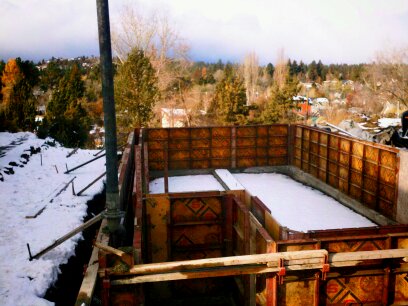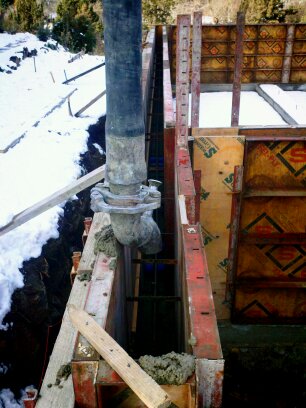21 Nov Using Fly Ash: Greener Concrete
 The foundation is well underway at Desert Rain, the Living Building Challenge home we are building in one of Bend, Oregon’s older neighborhoods. At every step of the way, this project involves careful consideration of the materials used, where they come from, how they are manufactured, how they will perform, and how they will effect the occupants of the home. So it is no surprise, that we are using a green product for the concrete foundation.
The foundation is well underway at Desert Rain, the Living Building Challenge home we are building in one of Bend, Oregon’s older neighborhoods. At every step of the way, this project involves careful consideration of the materials used, where they come from, how they are manufactured, how they will perform, and how they will effect the occupants of the home. So it is no surprise, that we are using a green product for the concrete foundation.
 The Downside of Cement
The Downside of Cement
Basic concrete is a mixture of cement, aggregate, and water. Manufacturing cement takes a lot of energy. For every ton of cement manufactured, about 6.5 million BTUs of energy are consumed. In the production of each ton of cement, about one ton of carbon dioxide is released. Experts estimate that cement production contributes to about 7 percent of carbon dioxide emissions from human sources. For every ton of cement that is replaced by an alternative substance, we save enough electricity to power the average American home for 24 days, and reduce carbon dioxide emissions equal to two months use of an automobile.
Using Fly Ash
Fly ash, which is the particulate matter collected by pollution-control equipment from the smokestacks of coal-burning power plants, can be used as a substitute to cement. In addition to being a substitute for cement, using the fly ash diverts this power plant bi-product from the waste stream. Mixes in which up to 25% of the cement is replaced by fly ash are quite common. The concentration of fly ash in the concrete for the Desert Rain foundation has 2-3 times the amount of fly ash traditionally used.
 Increasing Performance
Increasing Performance
When cement cures, it leaves behind some hydrated lime. Adding fly ash allows that lime to cure as well, making the concrete stronger and less porous. In general, the resistance of a concrete structure to corrosion, depends on the water-tightness of the concrete. The water-tightness is greatly influenced by the amount of mixing-water, type and amount of supplementary cementing materials, curing, and cracking resistance of concrete. High-volume fly ash concrete mixtures are able to provide excellent water-tightness and durability.



